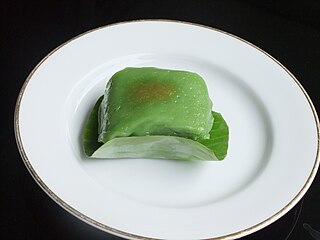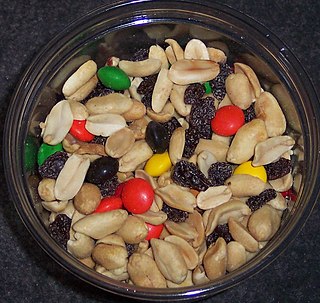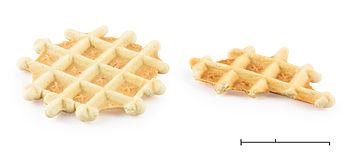
A waffle is a dish made from leavened batter or dough that is cooked between two plates that are patterned to give a characteristic size, shape, and surface impression. There are many variations based on the type of waffle iron and recipe used. Waffles are eaten throughout the world, particularly in Belgium, which has over a dozen regional varieties. Waffles may be made fresh or simply heated after having been commercially cooked and frozen.

Malay cuisine is the traditional food of the ethnic Malays of Southeast Asia, residing in modern-day Malaysia, Indonesia, Singapore, Brunei, Southern Thailand and the Philippines as well as Cocos Islands, Christmas Island, Sri Lanka and South Africa.

A waffle iron or waffle maker is a kitchen utensil used to cook waffles between two hinged metal plates. Both plates have gridded indentations to shape the waffle from the batter or dough placed between them. The plates are heated and the iron is closed while the waffle bakes. Waffles are a dessert with a light and sweet flavor, similar to pancakes. Their appearance is much harder to achieve than a pancake's without a waffle iron. Similar technology is employed to bake wafers, and several other snacks including kue gapit, a waffle-shaped but crunchy Indonesian snack which can be made with both sweet and savoury flavours.

Kuih are bite-sized snack or dessert foods commonly found in Southeast Asia and China. It is a fairly broad term which may include items that would be called cakes, cookies, dumplings, pudding, biscuits, or pastries in English and are usually made from rice or glutinous rice. In China, where the term originates from, kueh or koé in the Min Nan languages refers to snacks which are typically made from rice but can occasionally be made from other grains such as wheat. The term kuih is widely used in Malaysia, Brunei, and Singapore, kueh is used in Singapore and Indonesia, kue is used in Indonesia only, all three refer to sweet or savoury desserts.

A rice cake may be any kind of food item made from rice that has been shaped, condensed, or otherwise combined into a single object. A wide variety of rice cakes exist in many different cultures in which rice is eaten and are particularly prevalent in Japan. Common variations include cakes made with rice flour, those made from ground rice, and those made from whole grains of rice compressed together or combined with some other binding substance.

Kue is an Indonesian bite-sized snack or dessert food. Kue is a fairly broad term in Indonesian to describe a wide variety of snacks including cakes, cookies, fritters, pies, scones, and patisserie. Kue are made from a variety of ingredients in various forms; some are steamed, fried or baked. Kue are popular snacks in Indonesia, which has the largest variety of kue. Because of the countries' historical colonial ties, Koeé (kue) is also popular in the Netherlands.

Cirebon Regency is a regency (kabupaten) of West Java, Indonesia. Sumber is its capital. It covers 1,070.29 km2 and had a population of 2,068,116 at the 2010 census and 2,270,621 at the 2020 census; the official estimate as at mid 2021 was 2,290,967. These area and population figures exclude those of Cirebon City, which is an independent administration, although totally surrounded by the regency on its landward side.

Javanese cuisine is the cuisine of Javanese people, a major ethnic group in Indonesia, more precisely the province of Central Java, Yogyakarta and East Java.

A great variety of cassava-based dishes are consumed in the regions where cassava is cultivated, and the ingredient is included many national or ethnic specialities.

Clorot, celorot, cerorot, or jelurut is an Indonesian traditional sweet snack made of sweet and soft rice flour cake with coconut milk, wrapped with janur or young coconut leaf in cone shape. It is a popular traditional sweet snack commonly found in Brunei, Indonesia, and Malaysia.

Betawi cuisine is rich, diverse and eclectic, in part because the Betawi people that create them were composed from numbers of regional immigrants that came from various places in the Indonesian archipelago, as well as Chinese, Indian, Arab, and European traders, visitors and immigrants that were attracted to the port city of Batavia since centuries ago.

Kue bugis is Indonesian kue or traditional snack of soft glutinous rice flour cake, filled with sweet grated coconut. The name is suggested to be related to Bugis ethnic group of South Sulawesi as their traditional delicacy, and it is originated from Makassar. In Java the almost identical kue is called kue mendut. Kue bugis, together with kue lapis and nagasari are among popular kue or Indonesian traditional sweet snacks, commonly found in Indonesian traditional marketplace as jajan pasar.

Kue mangkok or kue mangkuk is an Indonesian kue or traditional snack of steamed cupcake. Kue mangkok means "bowl/cup cake". It is similar to the snack bolu kukus. While both have a similar appearance, bolu kukus requires few ingredients to make, whereas kue kangkok requires more than a dozen in most recipes. The result is a different texure: bolu kukus is soft and fluffy, while kue mangkok has a rough texture.

A snack is a small portion of food generally eaten between meals. Snacks come in a variety of forms including packaged snack foods and other processed foods, as well as items made from fresh ingredients at home.

Palembangese cuisine is the cuisine of the Palembangese people of the city of Palembang in the South Sumatra province of Indonesia. It is the second most well-known cuisine from Sumatra after Padang.

Kue rangi or also called sagu rangi is an Indonesian coconut kue or traditional snack made of a coconut and starch-based batter and cooked in a special molded pan. It is one of the traditional Betawi snack of Jakarta. Kue rangi often described as Indonesian coconut waffle.

Kue pukis or simply called Pukis is an Indonesian kue or traditional snack made of a wheat flour-based batter and cooked in a special mold pan. It is a commonly found snack in Indonesian traditional markets.

Kue pancong, kue pancung, bandros, gandos, or buroncong is an Indonesian kue or traditional snack made of a rice flour and coconut-based batter and cooked in a special mold pan. It is a commonly found snack in Indonesian traditional markets. Kue pancong is usually associated with Betawi cuisine of Jakarta, while bandros is often associated with Sundanese cuisine of Bandung city, and buroncong with Makassarese cuisine of Makassar, although all refer to the same coconut hot cake.

Kue talam is an Indonesian kue or traditional steamed snack made of a rice flour, coconut milk and other ingredients in a mold pan called talam which means "tray" in Indonesian. The cake mold used to create kue talam are either larger rectangular aluminium tray or smaller singular cups made from ceramics, aluminium, melamine or plastic.

Indo cuisine is a fusion cooking and cuisine tradition, mainly existing in Indonesia and the Netherlands, as well as Belgium, South Africa and Suriname. This cuisine characterized of fusion cuisine that consists of original Indonesian cuisine with Eurasian-influences—mainly Dutch, also Portuguese, Spanish, French and British—and vice versa. Nowaday, not only Indo people who consume Indo cuisine, but also Indonesians and Dutch people.





















